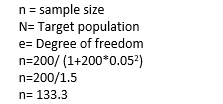Research context
Research background
Total quality management is critical in monitoring the efficiency and proactive organizational culture in line with the objective, goals, and mission of such an organization. Quality improvement facilitates sustainable and optimal use of resources in service delivery (Adhikari, 2011). Emirate of Sharjah is one of the seven cities in the UAE. The city has been in the forefront of managing quality through intrinsic implementation of the quality standards expected of them. However, the city has not achieved certification credits for its endeavors to create a tight management system within its operations. In many jurisdictions, it is mandatory to have independent TQM processes in the government institutions (Kinicki & Kreitner, 2009). Fortunately, implementation of the proposed ISO 14001 standards in the city will be efficient in taking up key control issues. Thus, it is important to review some of the implementation strategies that the city administration should adopt and relate them to the ISO 14001 standards (MacKay & McKiernan, 2008).
Rationale of the study
Implementation of the ISO 14001 standards strategy is a systematic measure that is instituted by an organization in order to maintain efficient and cost effective operation matrix. Therefore, it is important to have effective ISO 14001 standards for controls within the Emirate of Sharjah to ensure efficiency. The results of this research may be used by the city to improve the total quality management system and implement desirable business decisions which would influence profitability, efficiency, and survival amidst competition and market swings in the UAE (Escrig-Tena, Bou-Llusar, Beltran, & Roca-Puig, 2011).
Research questions and aims
The following are the research questions:
- To what extent, if any, does of the lack of ISO 14001 standards affect performance of the Emirate of Sharjah?
- Is there a relationship between the ISO 14001 standards implementation and TQM especially on the facets of efficiency at the Emirate of Sharjah?
The aims and objectives of this research paper are:
- Gauge and quantify the reasons for the current level of inefficiency associated with the Emirate of Sharjah as related to lack of the ISO 14001 standards implementation.
- Identify the management strengths that will exist within the hierarchy of authority and management faculty at the Emirates of Sharjah following the successful implementation of ISO 14001 standards.
Research methodology
Research approach
The research will be carried out through quantitative research using primary data. The quantitative approach was informed by the fact that the research is focused, subjective, dynamic, and discovery oriented. This approach is best suited to gain proper insight into the situation of the case study. Besides, quantitative data analysis will create room for further analysis using different and divergent tools for checking the degree of error in the assumptions (De-Rada, 2005).
Description of the population
This research will be conducted using research survey study approach. The researcher will dispatch 200 questionnaires as part of the quantitative survey. The research will be declared effective when 180 questionnaires are fully filled and returned. This research will target senior and junior staff at the Emirate of Sharjah (De-Rada, 2005). The researcher will use convenience sampling. The main reason behind the use of convenience sampling technique is that it is not only cost-effective but also time saving. To generate the sample size for this study population, the research will adopt the formulae created in 1972.
n=N/ (1+N (e2))
Where:

Justification of the method used
Use of the quantitative research approach is necessary in facilitating the primary data collection. This approach will allow the researcher to enter observed similarities and differences in data by different researchers. This methodology is helpful in identification of statistical patterns in the data collected.
Potential problems
The responses from the participants will be coded accordingly. One major weakness of this data analysis method is that it tends to transform qualitative data into semi-quantitative data by giving it labels and tags. In this case, the qualitative data will be tagged and labeled according to the research question and research objective they address. However, a major strength of the methodology is that it helps in analyzing all themes, which have implications on the research questions; hence the bias will be minimal. In spite of its inability to highlight themes that are external to the research questions conclusively, the methodology is appropriate for this study. In other words, the researcher will study the texts from the data collected trying to identify the concepts that relate to the research questions and objectives to minimize any bias (De-Rada, 2005).
References
Adhikari, B. (2011). Integration of ISO 9001 and ISO 14001: A Study of Common Elements. Menomonie, NY: University of Wisconsin.
De-Rada, V. D. (2005). Influences of questionnaire design on response to mail surveys. International Journal of Social Research Methodology, 8(1), 61-78
Escrig-Tena, A., Bou-Llusar, C., Beltran, M., and Roca-Puig, V. (2011). Modeling the implications of quality management elements of strategic flexibility. Advances in Decision Sciences, 1(1), 1-27.
Kinicki, A., & Kreitner, R. (2009). Organizational behavior: Key concepts, skills & best practices. New York: McGraw-Hill Irwin.
MacKay, B., & McKiernan, P. (2008). The role of hindsight in foresight: refining strategic reasoning. Futures, 36(3), 161-179.